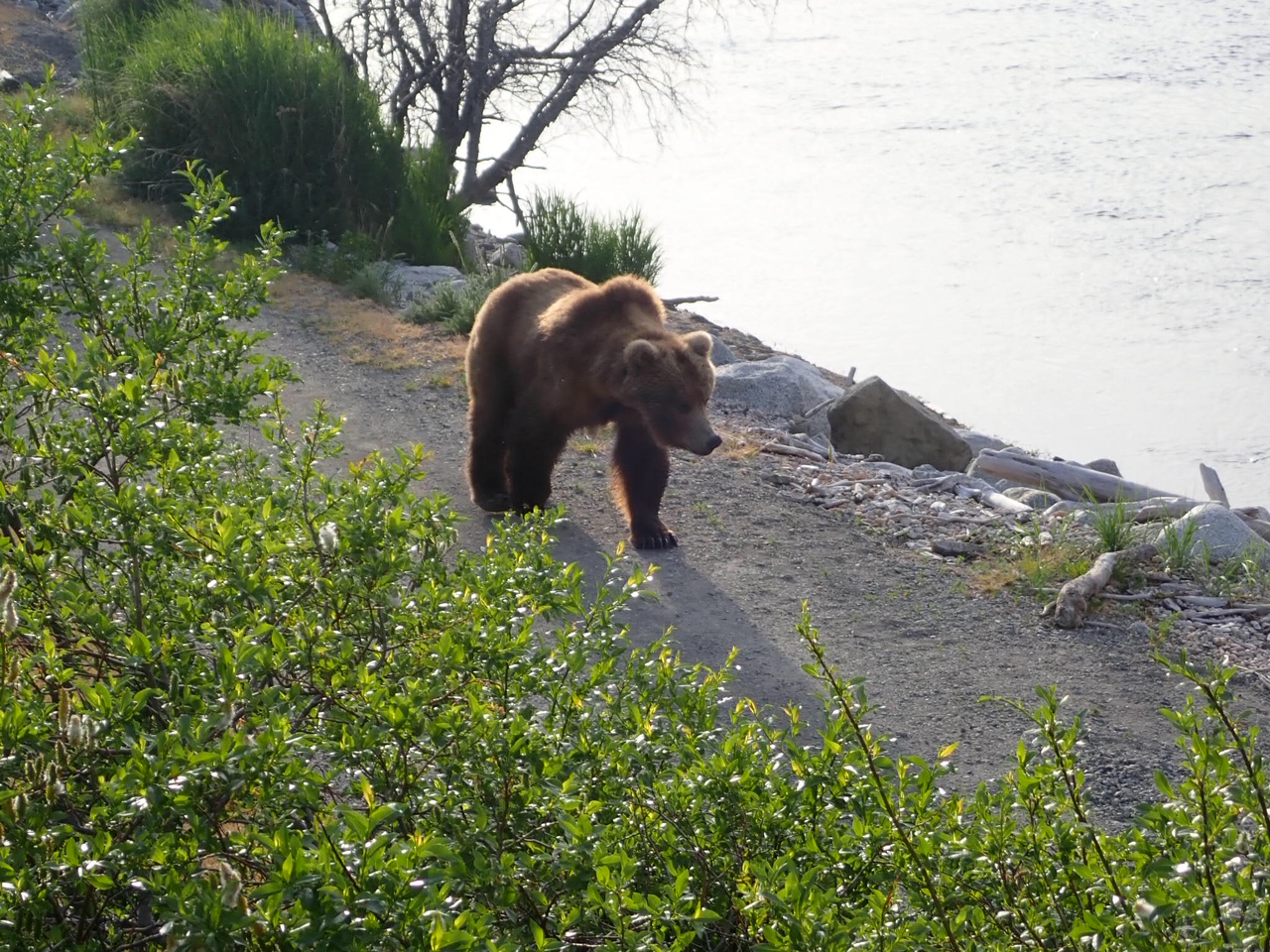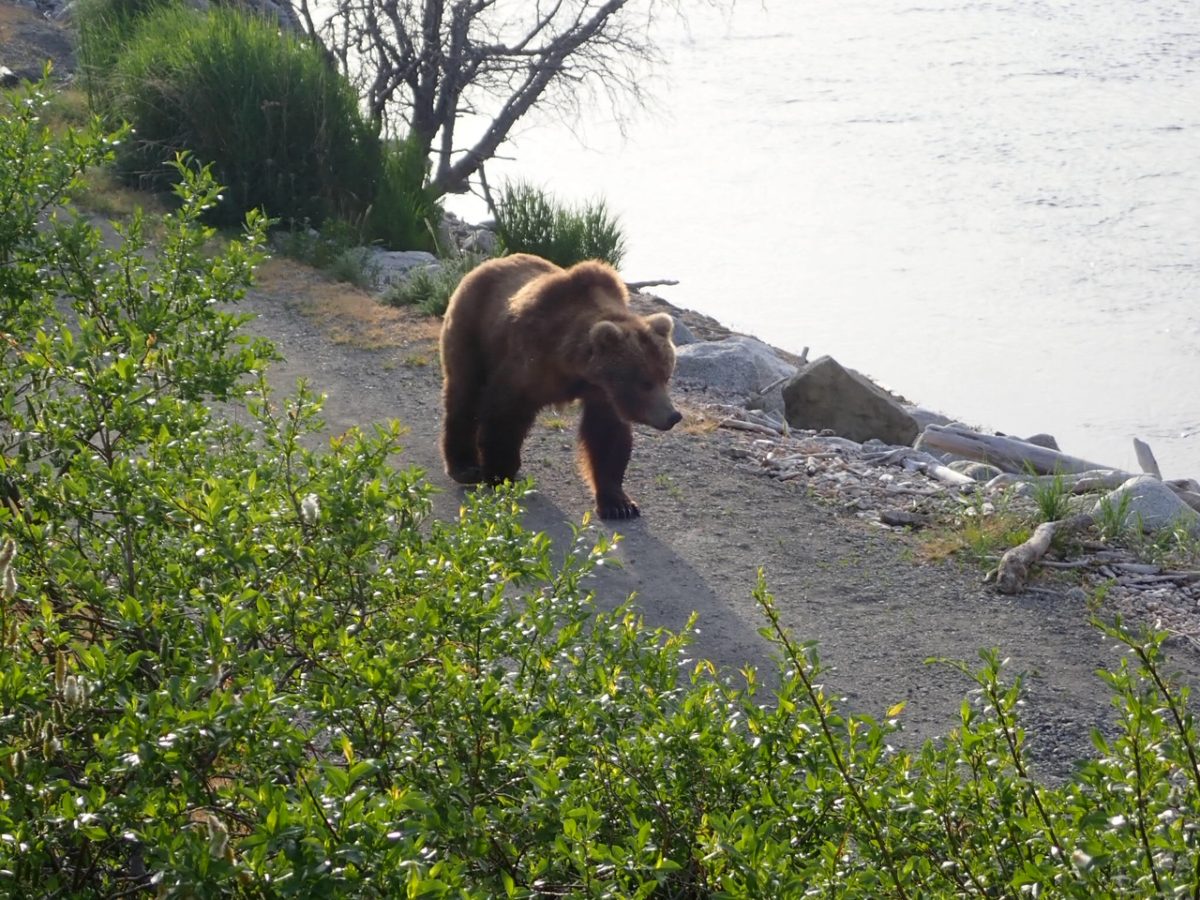Bears at Katmai National Park and Preserve
There are several national park units where a major part of the adventure is the ability to see wildlife in its natural habitat. This is especially true at Katmai National Park and Preserve in Alaska. There are bears throughout the area, but if you visit Brooks Camp in season you are virtually guaranteed to see bears. Not just one or two, but dozens!
The annual salmon run at Brooks River draws the bears, providing the protein diet they need to fatten up after a long winter hibernation. The “big boys” will hang out at the waterfall and scoop salmon up as they attempt to leap the falls on their journey up river to spawn. (You’ve probably seen this in videos and if you haven’t – check out the live bear cam at go.nps.gov/bearcam. It’s almost as good as being there.)
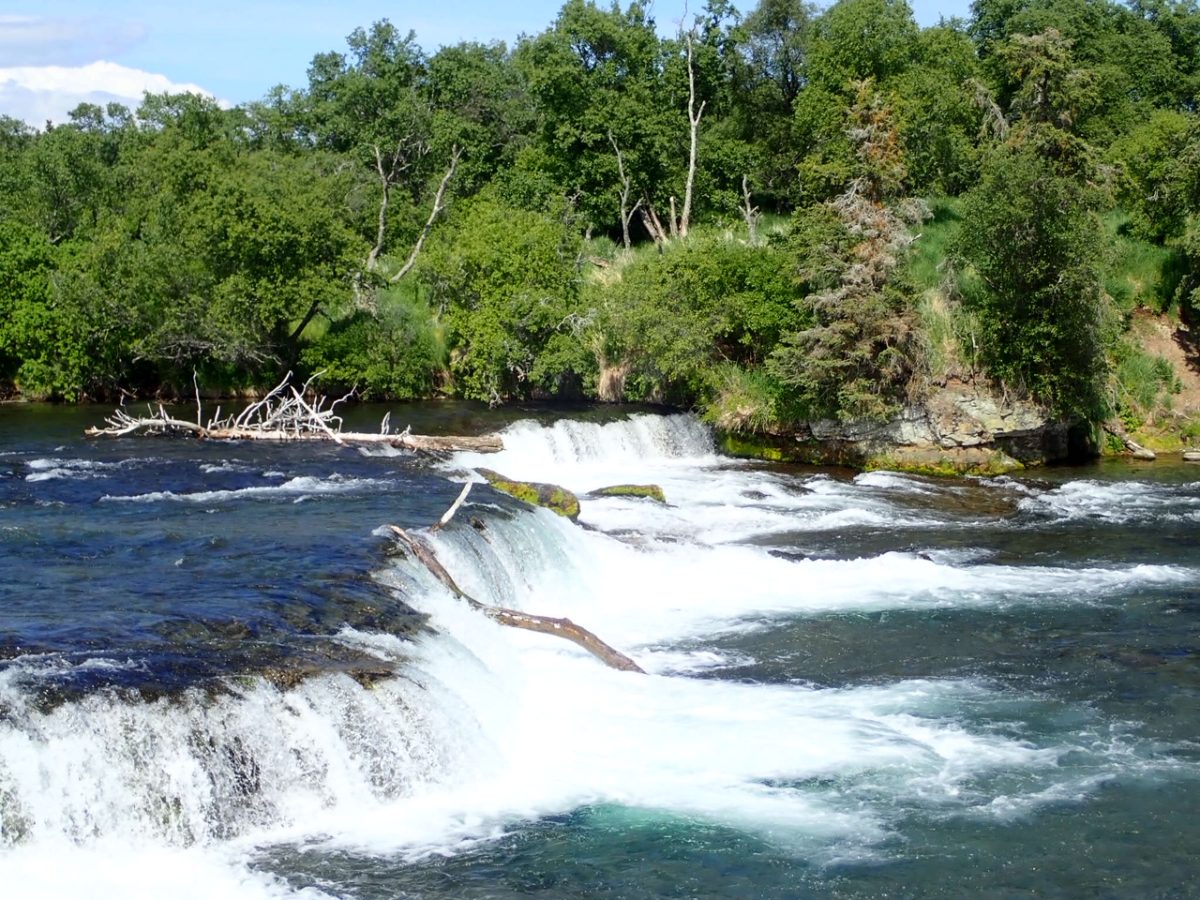
Smaller bears, sub-adults. and the mothers and their cubs, remain downstream feasting on the salmon at a safe distance away from the larger bears. There are so many salmon that the bears often will only eat the best fleshy part, leaving the rest for the gulls who hang out there knowing they will be fed.
Viewing Platforms at Katmai National Park and Preserve
The National Park Service has built a raised wooden viewing platform at the waterfall, as well as one downstream at the riffles, where you can safely watch the bears. You may be only 20 or 30 feet away, but they aren’t really interested in you with all that salmon around to feed on.

The viewing platform at the falls is about a mile and a half from the lodge. To get there, first you will cross the river on a brand new bridge, also set up with viewing platforms for watching the bears. The bridge is new this year. Prior to this, folks had to cross the river on a path where they were frequently held up due to “bear jams”.
This new bridge lets the people pass over the river and gives the bears room to walk below. The National Park Service is hoping that the bridge and people on it won’t disrupt the bear’s activities. Rangers are out there keeping an eye on things, but so far, it doesn’t seem to bother the bears. When we were there, a bear walked along the beach, under the bridge, out to the river and then came back and sat right below us and ate grass. Almost as if he was posing for photos!
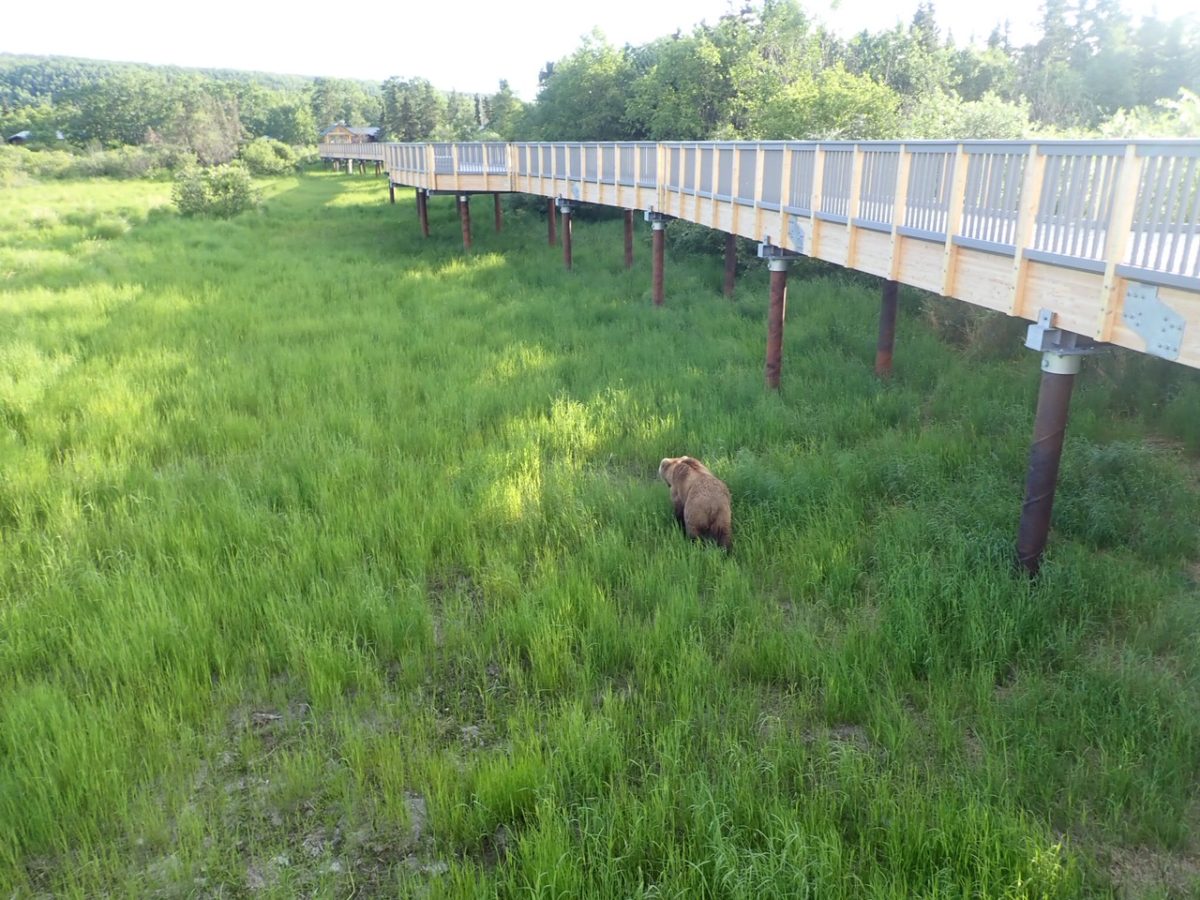
After you cross the bridge, you will walk on a gravel road up and then on a forest path over to the viewing platform at the bridge. During that part of the walk, there is no protection. A bear may pop out from the forest at any time – in front of you, behind you or right where you are. The best protection you have is to make lots of noise as you walk so that they avoid you. Once again, they really aren’t interested in you.
Bear Safety
Every visitor to Brooks Camp must begin at the visitor center where you will receive bear safety training. This goes through park regulations and walks you through how to best keep yourself and others safe in bear country.
They are quite strict about bear safety. NO food, not even chewing gum, is allowed outside of any building or electric fenced area. Don’t even think about picking up a coffee at the lodge and enjoying it on the bridge as you enjoy watching the bears. You will get reprimanded by a ranger!
Take it seriously. Bear awareness is vital to keeping everyone safe.
How to get to Katmai National Park and Preserve
There are several lodges within Katmai National Park and Preserve, plus lots of back country options. We only went to Brooks Camp. There you will find both a campground and a lodge with a restaurant and bar, plus a small store for sundries. You can get to Brooks Camp by boat or float plane.
We flew into King Salmon on a scheduled commercial aircraft, and then took a float plane from there to Brooks Camp. It’s only about 30 minutes. You land on Naknek Lake right by the lodge.

While it is possible to charter a flight to Katmai, see the bears and depart the same day, we would recommend that you plan to spend at least 2 days. The bears are great, but there is much more to see at the park.
In fact, the establishment of Katmai as a National Monument in 1918 had nothing to do with the bears! The national monument was established to protect an area that had experienced one of the largest volcanic eruptions in recorded history.
Valley of 10,000 Smokes
A visit to Katmai is not complete without a visit to the Valley of 10,000 Smokes, available as a ranger-led tour. It’s an all day bus trip but well worth your time. The scenery is spectacular.

The valley was crated by the eruption of the Novarupta volcano on June 6, 1912. It sent ash 100,000 feet into the atmosphere; darkening skies and covering everything for miles around. When explorers first came into the valley they saw thousands of smoking steam vents. You won’t see these today, but you will see the miles of ash and a river that has carved a path through the valley.

A short hike takes you down to the river where you will see the canyon walls – 18 foot cliffs of compressed ash. Pick up some of the rocks laying about… most are pumice and weigh nothing! Surprisingly, they are colorful – reds and yellows, as well as grey.

It was such a gorgeous place, we wished we could have spent more time there.
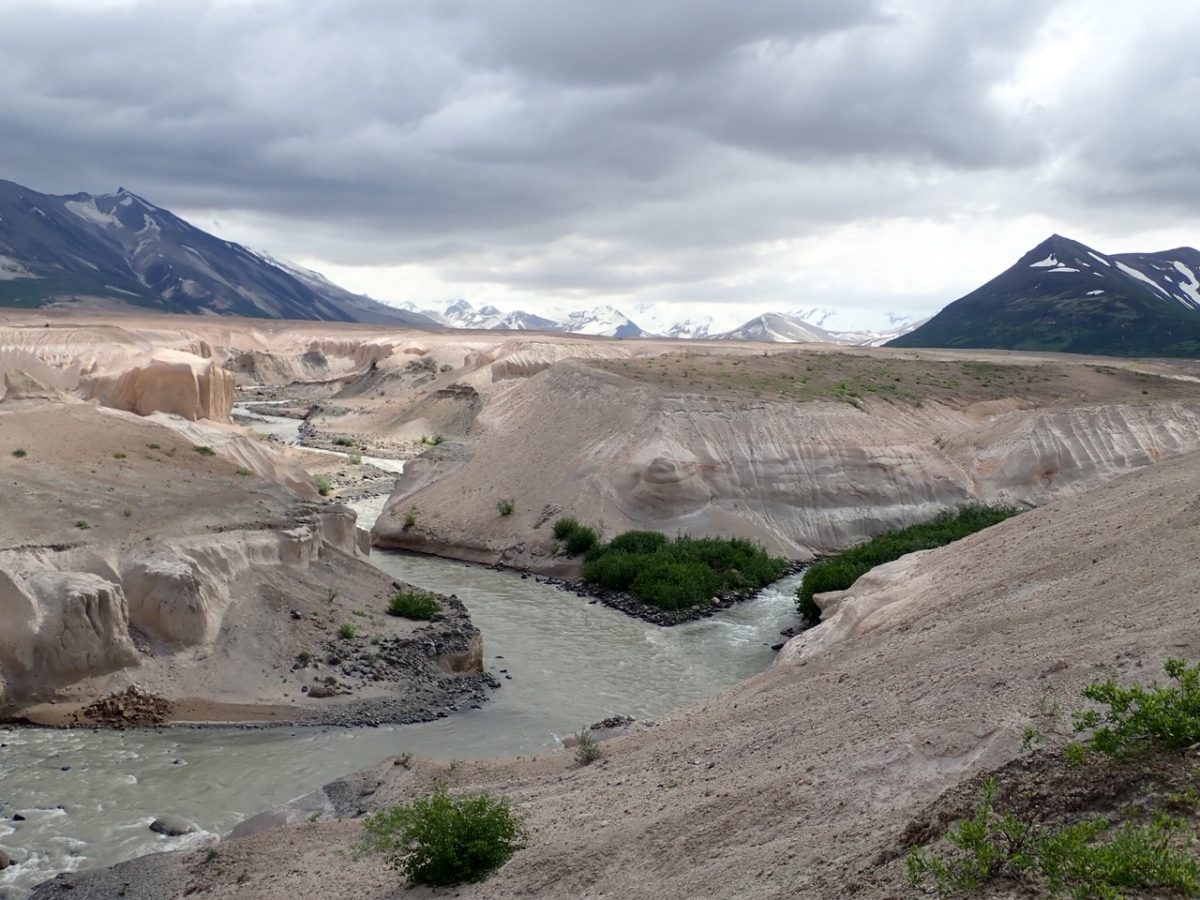
Human History in Katmai National Park and Preserve
Katmai National Park also protects 9,000+ years of human history. There are remains of over 900 dwellings in the park. A ranger-led culture walk will show you some of the remnants of these homes as well as a reconstructed dwelling. It is interesting to hear how people survived and thrived in these remote valleys long ago; where much like the bears, life centered around the salmon.

Other things to do at Katmai National Park and Preserve
Each day there are different ranger programs; talking about the human history, volcanic past, and of course, the wildlife. Along with the bears, we loved watching the waterfowl especially the merganzer ducks with their babies on their backs. We saw one with a “nursery” of over 17 chicks. So cute.
We also saw the resident porcupine and a moose. And, as you watch for bears from the bridge, look down. The water is so clear that you can see the fish. Not only does Katmai protect important habitat for salmon, the Brooks River is full of trout – a fly-fisherman’s paradise!
If you are more adventurous, there is also a hike up nearby Dumpling Mountain. It is a bit of a climb, but the views out over the valley, Brooks Lake and Naknek Lake are worth it. As you reach the top, you will be hiking on tundra – an experience in itself!

Where to stay at Katmai National Park and Preserve
Brooks Camp offers cabins and a campground, encircled by electric fence so you can sleep safely even knowing there are bears in the vicinity. The campground has a wooden shed for food storage and lean to’s with picnic tables. There are also food and gear storage sheds and fenced picnic areas near the ranger station.

Cabins and campsites require reservations, probably some time in advance especially if you want to visit during the high “bear” season (end June through July).
If your goal is to see bears, Katmai will not disappoint!

